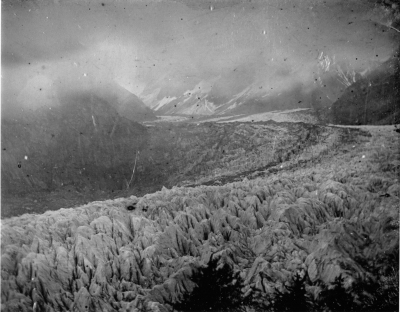Ruskin Library: Exhibition

'Mer de glace Chamonix' by John Ruskin-one of the earliest
photographs ever taken in the Swiss Alps.
Ruskin restored: further drawings and daguerreotypes from the HLF Conservation Project
A new selection of art on show at Lancaster University's Ruskin Library, is taken from more than 400 drawings and watercolours by Ruskin conserved over the last three years, thanks to a substantial grant from the Heritage Lottery Fund. Also on show for the first time since their examination and conservation are many examples from the important collection of 125 historic early daguerreotypes bought or made by Ruskin in the 1840s and 1850s, including some of the earliest photographs ever taken in the Swiss Alps.
Made possible by a substantial grant from the Heritage Lottery Fund, the conservation of more than four hundred drawings and watercolours by John Ruskin (1819-1900) has taken place over the last three years. Ruskin was one of the first to realise the damaging effect of light on drawings, and used baize covers to protect the Turner watercolours at Brantwood, his home at Coniston. In more than a hundred years since his death, many of his own superb drawings have deteriorated for a number of reasons – chiefly through decay of acidic board to which they were attached, and from the effects of over-exposure to light.
Museum Conservation Services Ltd, in their studio at Duxford, near Cambridge, have conducted a remarkable variety of treatments to stabilise, repair and where appropriate, improve the appearance of many drawings which previously could not have been displayed. This has ranged from straightforward (but time-consuming) removal from decayed supports to immersion in chemical solution and treatment with enzymes. Repairs to tears and other surface abrasions have been carried out, with many sheets requiring the inlaying of weak and fragile supports – Ruskin was surprisingly careless in his choice of paper, some of which is of poor quality. Acid-free mounts have been provided throughout, many of some elaboration in order to retain important original inscriptions and to show significant drawings on the reverse.
The first batch of works was delivered in June 2002, and the project finally declared complete in October 2005. Following the year-long exhibition in 2003-04, this new selection of conserved drawings again contains subjects covering the historical range of works in the collection, chiefly illustrating a lifelong devotion to the study and record of landscape, architecture and the natural world.
Also on show for the first time since their conservation are some of the 125 historic early daguerreotype photographs, assembled by Ruskin in the 1840s and 1850s, and including historic images such as the Mer de Glace, Chamonix, one of the earliest photographs ever taken in the Alps. As one-off images, all daguerreotypes are rare, but those with known history and accompanying documentation are of exceptional significance. They have required thorough technical examination before surface cleaning (where necessary) and the replacement of decayed glass and paper seals, to prevent further oxidisation: the original paper mounts have also been conserved and retained, to preserve Ruskin’s preferred presentation, within detachable acid-free mounts allowing wall display if required.
The Director of the Ruskin Library, Stephen Wildman, said: “One of the Ruskin Foundation’s aims in establishing the Library was to improve the condition of this unique collection of drawings and photographs. The Heritage Lottery Fund, who made the library building possible in the first place, has again been generous in supporting the cost of this ambitious conservation programme. We now have over 400 drawings which can be shown both here and in exhibitions elsewhere, as well as an astonishing group of daguerreotypes, one of the most important collections of its kind in the world. The conservation itself is of the highest standard and interest, involving the most modern techniques of examination and treatment.”
7 January - 23 April 2006
Ruskin Library, Lancaster University, Lancaster LA1 4YH
http://www.lancs.ac.uk/users/ruskinlib/ Tel: 01524 593587
Galleries open throughout the year
Monday to Saturday 11 - 4, Sunday 1 - 4
Admission free
Additional items from the collection are displayed at Ruskin’s last home at Brantwood, on Coniston Water in the Lake District (also open to the public: 015394 41396 www.brantwood.org.uk)
For full listings of arts events at Lancaster University please see the following weblink. http://domino.lancs.ac.uk/info/lunews.nsf/r/322e